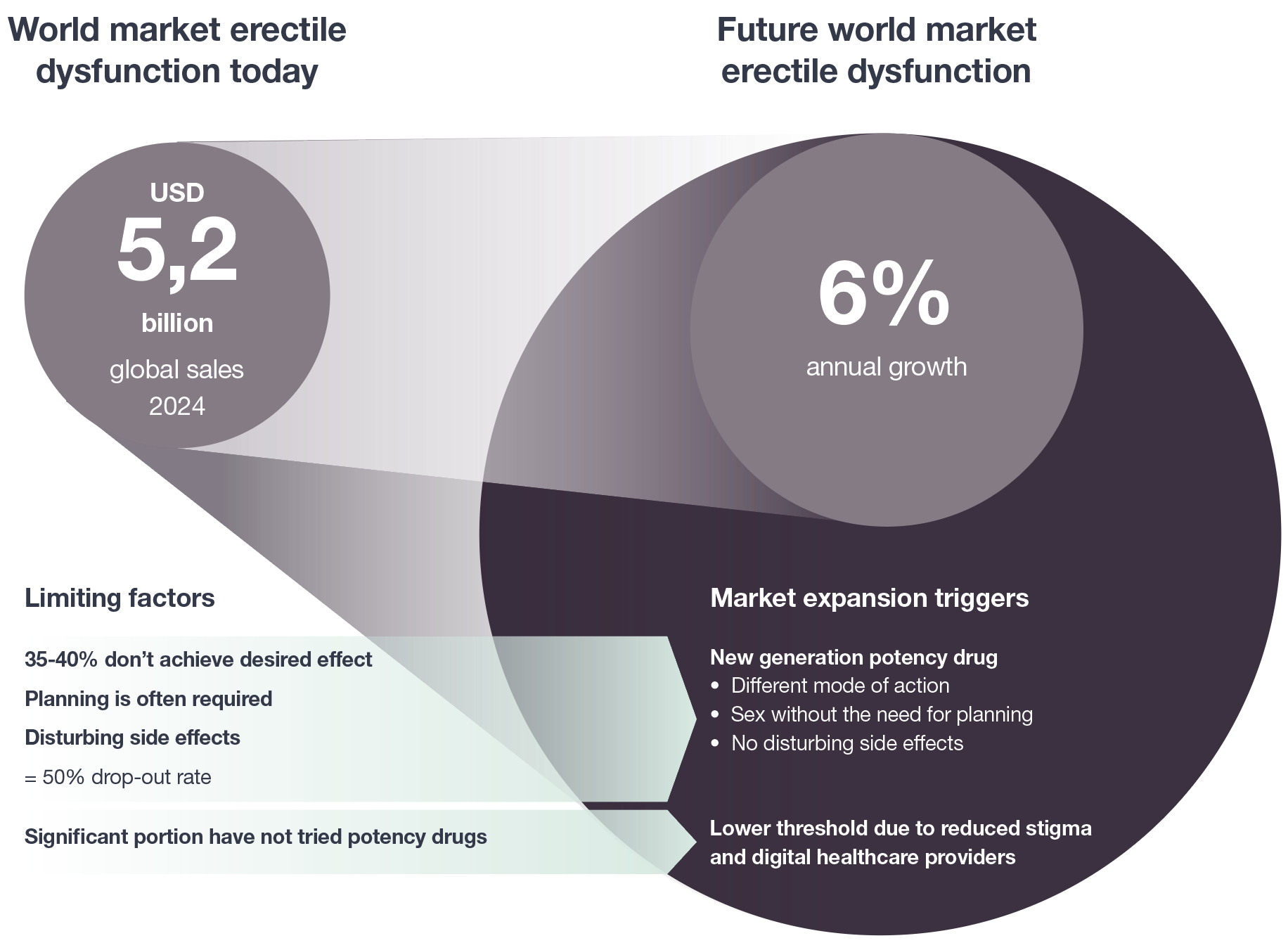The market for erectile dysfunction
The global sales of potency drugs amounted to approximately 5,2 billion USD in 2024. It's worth noting that many who perceive a great need for these treatments refrain due to side effects, perceived poor efficacy, or frustration with the planning required. Sales forecasts show an expected annual increase of 6%.

Erectile problems do not necessarily mean a complete loss of erection but can also entail a reduced ability to maintain a strong and lasting erection. This results in a weak erection and the inability to complete intercourse. Reduced erectile function is very common and increases with age. Since the definition of erectile problems varies slightly between studies, the figures can differ somewhat.
The global population with erectile dysfunction is expected to reach 461 million men by 2030. Several studies show that the prevalence increases with age, the older the population, the higher the prevalence. For example, a prevalence of 49% has been observed among sexually active men between 50 and 80 years in the USA, France, Germany, Italy, Spain, the United Kingdom, and the Netherlands, and a prevalence of 52% among men aged 40 to 70 years in Boston, USA.
Global sales for the treatment of erectile dysfunction amounted to approximately 5 billion USD in 2023, with an expected annual increase of around 7% until 2028. The sale of potency drugs has increased significantly in recent years. In large Western markets, the number of sold preparations has increased by 41% since 2018. This increase is driven by factors such as an aging population, lifestyle factors, increased awareness of potency problems, reduced stigma, and an improved healthcare infrastructure.
Erectile dysfunction has several underlying causes, including obesity, stress, chronic diseases, and psychological disorders. Stress is expected to become more common in Europe and North America. Diabetes is one of the chronic diseases contributing to erectile dysfunction and is an important factor behind the increase. Erectile dysfunction caused by age-related diabetes is expected to increase the prevalence by 1% per year until 2040.
Assessed prevalence of ED diagnosis or PDE5I prescription by age, study based on a sample of 19,833,939 men in the US based on real-world observational data (claims data from MarketScan® databases and electronic health records from Humedica® database. Study funded by Pfizer Inc.)
Arizton, 2018; UN, 2017; JP Mulhall, 2016
Current treatments of Erectile Dysfunction
Today, there are several treatments for erectile dysfunction available on the market, and these can be divided into two main categories: pharmaceutical treatments and medical devices. The majority of sales come from pharmaceutical treatments, with the so-called PDE5 inhibitors dominating the market.
PDE5 inhibitors are prescription medications in almost all countries and come in several variations including generics and a few OTC-versions (Over-The-Counter) . Among the market leaders are Viagra (sildenafil), developed by Pfizer, Cialis (tadalafil), developed by Eli Lilly, and Levitra (vardenafil), developed by Bayer AG and GlaxoSmithKline.
PDE5 inhibitors are primarily used as needed, meaning they are taken a certain amount of time before intercourse. The effect starts to work approximately 30 minutes to an hour after ingestion, which requires planning. The mechanism of PDE5 inhibitors is to dilate the blood vessels in the penile erectile tissues, which increases blood flow and results in a stronger erection. However, these medications also affect blood vessels in other parts of the body.
Common side effects of PDE5 inhibitors include runny nose, headache, facial flushing, stomach pain, back pain, indigestion, temporary vision disturbances, fatigue, and dizziness. Serious side effects, such as severe blood pressure drops, have also been reported. Therefore, PDE5 inhibitors are contraindicated for patients with cardiovascular diseases and those using nitro preparations. Furthermore, up to 30-40 percent of patients with erectile problems show no effect from the treatment, including men with type 2 diabetes, who generally respond poorly to PDE5 inhibitors.
Overview of current Key Treatments
Viagra (sildenafil) including generics: A PDE5 inhibitor and the first on the market, often referred to as the "golden standard." Globally registered.
Cialis Tadalafil) including generics: Another PDE5 inhibitor, which today has higher sales than Viagra. Globally registered.
Limitations of Current Medications
- 30-40% of patients experience little or no effect, which also affects 70% of diabetes patients.
- Side effects include nausea, headache, dizziness, and blood pressure drops.
- Short duration of action, requiring undesirable planning of sexual activities.

